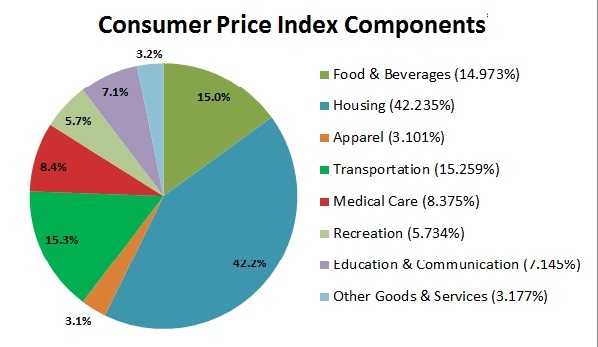
The Consumer Price Index, or the CPI as it is commonly known, is one of the most important economic indicators related to inflation used by foreign exchange traders and currency market analysts.
Traders typically use the CPI to evaluate the level of inflation in consumer goods. And changes in the level of the CPI have become an important determinant of the value of the U.S. Dollar against other currencies.
The following sections describe what the CPI is, who produces it and when it is released, in addition to going into detail about why this economic indicator is of such great importance to forex traders.
The US Consumer Price Index or CPI Report
Few economic indicators carry as much weight and influence on the forex market as the CPI Economic Indicator.
The number, which is released monthly by the U.S. Bureau of Labor Statistics, measures the change of the average of prices paid by consumers for a basket of goods and services.
The U.S. Consumer Price Index or CPI represents the most widely used measure of price inflation and is generally viewed as a gauge of how effective the government’s economic policy is on current conditions in the domestic economy. The number provides important information on price changes to government, labor, businesses and private citizens and is used as a guide for formulating economic policies for the Federal Reserve and Congress.
In addition, the indicator and its components are used to adjust other economic series and to translate these into inflation free dollars. Some examples of the series which are adjusted by CPI include Retail Sales, weekly and hourly earnings and other components of Product Accounts and National Income.
 What the Consumer Price Index Measures
What the Consumer Price Index Measures
The Consumer Price Index basically measures the average price for a basket of goods as experienced by two major population groups: clerical workers and all urban consumers. The all urban consumers group represents approximately 90 percent of the entire United States population and is based on the pricing experience of virtually all residents of major urban population centers.
The index reflects the expenditures of professionals, the poor, retired people, clerical workers and wage earners living in urban areas. Nevertheless, the index omits the spending information of people living in rural areas, farm operating families, those serving in the Armed Forces, and people living in institutions, such as those among the prison population and inmates at psychiatric facilities.
Furthermore, consumer inflation is measured by two indexes for all urban consumers. These consist of the Consumer Price Index for All Urban Consumers or CPI-U, and the Chained Consumer Price Index for All Urban Consumers or C-CPI-U. The Chained C-CPI-U uses a formula that reflects the effects of substitution made by consumers across item categories as a response to changes in relative prices.
The Headline CPI Number
The following goods and services are covered by the calculation the Bureau of Labor Statistics uses to compute the headline CPI number:
- Food and Beverages – these include milk, coffee, breakfast cereals, chicken, wine, snacks and full service meals.
- Housing – primary residence rentals, mortgages or owner’s equivalent rental, bedroom furniture and fuel oil.
- Apparel – clothing items, the prices of which tend to be quite seasonal.
- Transportation – this includes gasoline, new vehicles, airline fares and vehicle insurance.
- Medical Care – physician services, prescription drugs and other medical supplies, eye care and hospital services.
- Education and Communication – telephone services, college tuition, postage, computer software and other computer accessories
- Recreation – pets and pet products, televisions, sports equipment and entertainment admission fees.
- Other – personal services such as beauty care, financial services, funeral expenses, and tobacco and smoking products.
Figure 1 below shows the relative sizes in percentage terms of each of the above eight components of the headline CPI, aka the Consumer Price Index for Urban Consumers or CPI-U, as assigned by the Bureau of Labor Statistics when it was last reweighted in December of 2015.

Other items included in the headline CPI list are government user fees, such as sewage and water charges, vehicle tolls and automobile registration fees, sales and excise taxes, as well as other charges directly associated with the prices of specific goods and services.
Nevertheless, the headline CPI number excludes income and Social Security taxes, investments such as stocks bonds, life insurance and real estate prices, which relate to savings and are not related to the direct purchase of day to day consumer expenses.
The Core CPI Number
In addition to the headline CPI number, the Core CPI number, which is released simultaneously with the headline CPI result represents the change of prices in goods and services purchased by consumers with the exception of energy and food costs.
Due to the fact that food and energy costs make up more than a quarter of the CPI, and these prices tend to show a higher level of volatility, in many cases their fluctuations will distorting the underlying trend in inflation.
For this reason, many economists, forex traders and the FOMC tend to pay more attention to the Core CPI number than the regular headline Consumer Price Index widely reported by news agencies.
CPI Release Dates
The Core and headline CPI inflation data is generally released approximately 16 days after the end of each reporting month, although the actual release date can vary between the 14th and the 20th of each month.
The CPI data most commonly reported and watched by forex traders is the percent change in the average price of a basket of goods and services purchased by consumers compared to the previous month’s sampling.
Who Compiles and Releases the US CPI Numbers?
US CPI Numbers are compiled and released by the U.S. Bureau of Labor Statistics. The BLS data collectors, also called economic assistants, visit or call thousands of businesses, retail stores, rental units, services establishments and medical facilities in the United States to source the prices of thousands of items used in the measure of price changes in the CPI.
The BLS’ economic assistants track approximately 80,000 items monthly to gauge price fluctuations.
If the item or service is no longer available, or if there are changes in the quality or quantity of the item, the change is reflected or a new item is selected.
The information is then sent to the BLS’ national office where commodity specialists review the information and make any necessary changes or adjustments.
The Importance of CPI Data for Forex Traders
The Consumer Price Index provides forex traders with a measure of consumer goods inflation in the United States. The CPI indicator is often used along with the Producer Price Index or PPI to give a sense for the strength of inflationary pressures within the United States.
Monetary policymakers — like those who work at the Federal Reserve Bank and those who sit on the Federal Open Market Committee or FOMC as voting members — typically review the CPI numbers and any trends in recent results when deciding whether or not to adjust the level of benchmark interest rates like the Fed Funds Rate and the Prime Rate.
Changes in these key interest rates are then transmitted to the rest of the U.S. economy in the form of changes in lending and borrowing rates by commercial banks. Such changes can stimulate the economy if interest rates are lowered, or they can start to stifle the economy if interest rates are raised.
Headline Versus Core CPI Report for Forex Traders
Many newspapers and financial news wires tend to focus on reporting the actual US CPI number reported by the Bureau of Labor Statistics that includes food and energy prices. This US CPI news number quantifies the raw inflation figure as changes in the average cost of buying a fixed basket of consumer goods in the United States.
Since this raw inflation number typically makes headlines, it is therefore often referred to as “headline” consumer inflation among finance professionals.
In contrast to news reporters, many forex traders and fundamental analysts instead tend to focus preferentially on the Core CPI number. This is because the core number tends to be less volatile than the headline CPI number due to the fact that it excludes food and energy prices that tend to fluctuate widely within a given reporting month.
Their concern is that the volatility often observed in the headline CPI number from notable food and energy price changes can result in short term inflationary spikes that might obscure the fundamental trend in price increases to an analyst or trader looking to reveal them.
As a result, the Core CPI number can be and typically is used by a fundamental forex trader to provide a better sense of the underlying trend in consumer goods price inflation than the typically more volatile and unpredictable headline CPI number.
How is CPI Used by Forex Traders, and Why is CPI Important?
Forex traders who incorporate elements of fundamental analysis into their trading decisions typically use changes in the Consumer Price Index as a way of assessing the level of inflationary pressures in the U.S. economy from the perspective of the average U.S. based consumer.
In general, higher inflation in the United States as measured by the CPI is important to forex traders because it will usually translate into higher U.S. benchmark interest rates being set by U.S. monetary policymakers who sit as voting members on the Fed’s FOMC.
This is due to the fact that the policy setting FOMC members will tend to see rising consumer price inflation as a sign that they need to tighten monetary policy by raising benchmark interest rates to help dampen the economy and return price inflation to more subdued levels.
Furthermore, lower US CPI index inflation below the FOMC’s target levels will tend to result in lower U.S. benchmark interest rates since policymakers will see the U.S. economy as being in need of the stimulus that lower interest rates can provide.
The FOMC’s Inflation Target
The Federal Reserve Bank and the FOMC’s voting members generally see a modest amount of inflation as a good thing since it indicates a steadily growing economy. They will therefore generally set and make public a rough target for the level of inflation in the U.S. economy that they are aiming for.
Inflation targets in the two percent per annum region seem fairly common among central banks in major developed nations, although it can vary and remains subject to change.
In the case of the United States, its FOMC noted in its September 2016 rate statement that, “the Committee judges that inflation at the rate of 2 percent (as measured by the annual change in the price index for personal consumption expenditures, or PCE) is most consistent over the longer run with the Federal Reserve’s statutory mandate.”
If the FOMC makes public any decision to change this target inflation rate, such a change will generally be accompanied by a shift in value of the U.S. Dollar relative to other currencies, especially if the change is not widely anticipated and so comes as a surprise to currency traders and economists.
For example, if the FOMC raises its inflation target, then that will tend to decrease the value of the U.S. Dollar as real interest rates probably rise, while a reduction in the FOMC’s target inflation rate will tend to boost the U.S. Dollar because real interest rates would likely be reduced.
Typical Reactions of Forex Traders to Observed CPI Results
When forex traders see a strong US CPI number — with the word “strong” meaning that the result for the monthly percent change in the CPI was higher than expected — coming out as part of the broader CPI news release put out by the Bureau of Labor Statistics each month, that strength will be seen as an indication of tighter monetary policy and hence higher U.S. Dollar yields in future.
As a result of a strong CPI number, market makers will mark up the U.S. Dollar in its various exchange rates, and forex traders will typically buy the U.S. Dollar versus the currencies of other nations as an initial reaction to the higher CPI number.
Conversely, when forex traders see a weak CPI number come out that is below the market’s consensus expectation, they will tend to look at that as dampening expectations for higher benchmark interest rates and lower U.S. Dollar yields in future. This outcome will tend to cause the value of the U.S. Dollar to fall on in the foreign exchange market as forex market makers mark its value lower and traders sell the U.S. Dollar.
A CPI number that comes out more or less in line with the market’s consensus should have little impact on the forex market’s valuation for the U.S. Dollar, since the level of the observed result is already priced into the forex market’s U.S. Dollar exchange rate against other currencies.
Using CPI to Compute Real Interest Rates
As part of their fundamental analysis, some forex traders also like to subtract the CPI inflation number from prevailing U.S. interest rates to obtain a result for the real interest rate pertaining to the United States’ economy. This real interest rate number can then be compared to the analogous real interest rate prevailing in the economies of other countries.
Doing this analysis can help forex traders evaluate the potential for appreciation or depreciation of the U.S. Dollar relative to other national currencies since such trends tend to favor those currencies with higher real interest rates.
For example, if the real interest rate in the United States seems to be falling since the CPI is rising but benchmark interest rates remain stable, then that would be seen as a negative for the U.S. Dollar. A forex trader might therefore expect the U.S. Dollar to depreciate relative to currencies of countries with a real interest rate that is stable or rising.
On the other hand, if the real interest rate in the United States seems to be rising as CPI falls but benchmark interest rates remain stable, then that would tend to provide some underlying fundamental support for the U.S. Dollar and a trader might reasonably expect it to appreciate against currencies whose real interest rates were stable or falling.